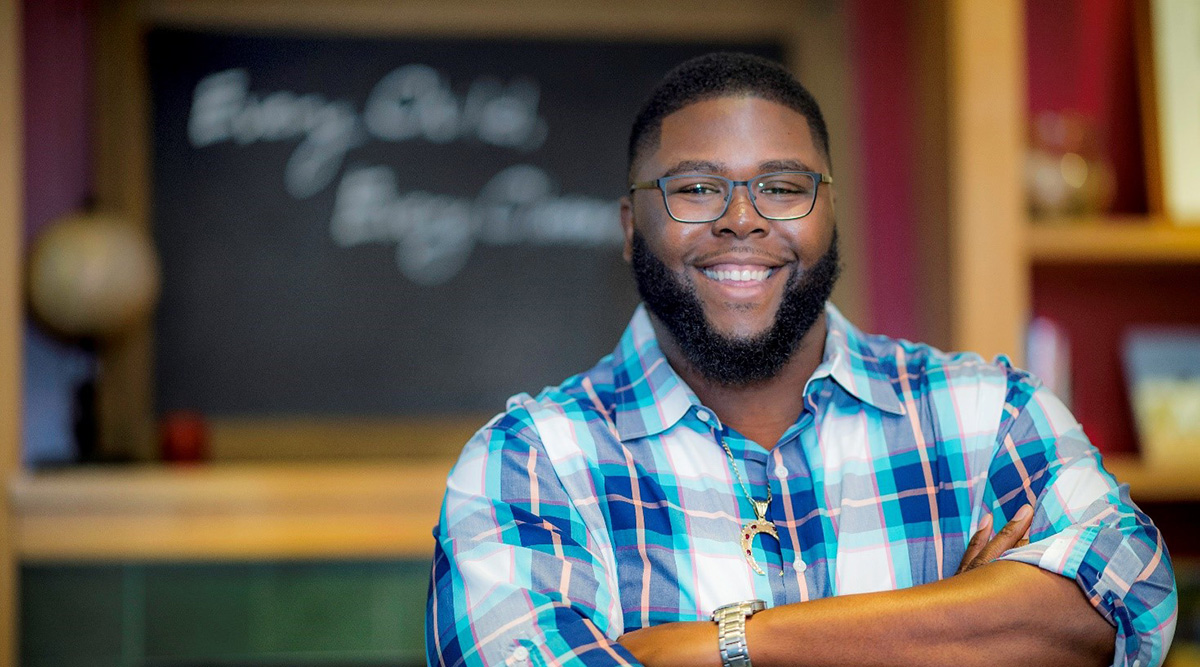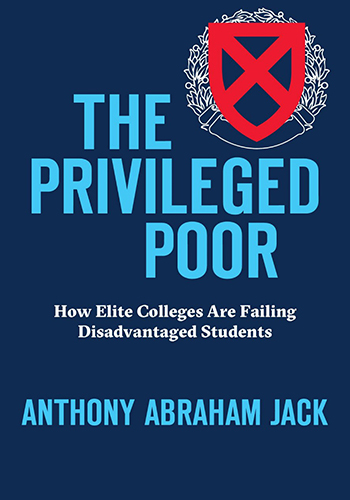
As the child of a single mother living in a neglected area of Miami, Florida, Anthony Jack, PhD, had few options for high-quality education. But his life shifted course when he received a scholarship to attend the prestigious Gulliver Preparatory School his senior year of high school. Jack’s time at Gulliver set him up for success at Amherst College, where he already understood higher education’s hidden curriculum.

Because he was a low-income student with this social capital, Jack was part of the “privileged poor” — a term he coined to describe students who don’t come
from wealth but who benefit from the opportunities afforded to them at elite private high schools. Contrast that with the “doubly disadvantaged” — low-income students who attend under-resourced public high schools and lack the insider knowledge to easily navigate college.
Neither group has it easy, though. While he understood how to move within an affluent, exclusive institution, Jack still felt the sting of poverty, like when campus shut down for spring break and he couldn’t eat in the cafeterias.
Now an assistant professor of education at the Harvard Graduate School of Education, Jack researches the experiences of the privileged poor and doubly disadvantaged. His new book, The Privileged Poor: How Elite Colleges Are Failing Disadvantaged Students, explores how the social capital that students gain in high school — as well as class, race, and ethnicity — factor into life at a top-tier university.
Jack spoke with AAMCNews about access versus inclusion in higher education and how the academic medicine community can better support its low-income, first-generation students.
How did your time at Gulliver Preparatory School ease your transition to college?
I always liken my time at Gulliver Prep to a one-year crash course in what Amherst would be like. Prep schools have long been breeding grounds, proving grounds, crucibles for the affluent in preparation for college.
For low-income students who make it into these schools, whether it’s as a scholarship student or as part of a program like Prep for Prep, it’s as much of a socialization process of how to be a certain type of student as it is about what you learn.
Over time, you become accustomed to a certain type of learning, a certain type of back-and-forth with adults, a certain type of expectation of how you will be pushed in a classroom not just on the material itself, but also on like how certain things are taught.
Most of your classes are seminars and discussion groups. They use the Harkness method of teaching, where you sit around a table and the professor sits back from the conversation as students lead these very, very in-depth conversations about a particular passage from Shakespeare or a quote from Morrison, or something like that.
What experiences were most isolating for you while at Amherst College?
Staying on campus during spring break was very isolating. People would ask me where to go in Miami for vacation. I was like, I don't know. Because even though I’m from Miami, I couldn’t afford to go to those places. So those first two years of not having anyone there, but also being hungry and having to scrounge for money, that was tough.
Living in that blind spot and going hungry and having to fend for yourself and do things that make you feel less than a full member of the community, it hurts and undercuts your sense of belonging and it makes you question a lot of who you are and if you should be there. You're already struggling because you're away from home and you want to do what you can, but it affects you.
When [my class] got to college, it was when [former Amherst College President] Tony Marx got there. There was a big push for diversity because that was his mission. And a lot of people questioned how we got in. Was it lower standards, was it the finger on the scale? Why was Amherst lowering its standards to make itself more diverse?
Those were some moments that I remember when people would say things, that it wasn't necessarily that you didn't hear them before, but they hit differently.
How should members of our academic medicine community address the hurdles that low-income, first-generation students face compared with their continuing-generation, wealthier peers?
What people are starting to see for lower-income or first-generation college students, let alone the combination of the two, is we still live in poverty’s long shadow. The opportunities that we have at our fingertips now, we don't have as strong of a grasp of them just because we are in medical school, because we are the first to go. So if your grandfather was a surgeon, and your mother was also a surgeon, you probably know not just that you want to go to medical school, but also what medical school you want to go to, what are your safeties, what specialty you want to do, what residency, and where you want to do your residency.
For other people, this is a dream coming true. This is trying to figure out, Oh, I'm here. I've gotten to the promised land. But now what do you do? How do we make it as explicit as possible?
We need to be intentional with the language that we use, and this goes beyond just creating a glossary. If there is something that is attached to access to resources or something that affects one's mobility, we cannot leave it to be deciphered by students. Because the more we leave to be decoded, it’s like playing telephone. Well, by the time they get to a first-generation college student, the message may not be the same.
How can we begin to move away from just talking about access to thinking more deeply about inclusion for our less-resourced medical students?
The key thing is to focus as much on who gets in as to how they make it through. Those are the two pieces that we need to put equal attention on. The admissions office and the recruiting and telemarketing team, they're going to get you your numbers. They're going to get you the students. If you have a forward-thinking dean and faculty, you're gonna benefit from saying “yes, and.” Yes, we got the students, and we can do better.
A lot of students who come to medical school, especially from low-income families, do it because of the trauma that they see at home, either in their own houses or in their community, and understand the toll that it can take on them.
Students navigate this gap between living out this life-long dream of being able to give back, but then also knowing that sometimes at two o'clock in the morning, you may get a call that forces you to leave campus because something happened at home that has more to do with poverty and inequality than it does with just the natural life cycle of aging.
I tell people all the time, when you start to recruit more low-income students from rural backgrounds and lower-income distressed communities, there are certain issues and problems that they will bring with them that you have to be willing to deal with, and that means diversifying and building out everything from not just financial aid, but your mental health services and your different support services.
What I want all graduate students, all graduate schools to understand, whether it's professional or for research, is the same thing I'm trying to get colleges to fully commit to believing: Acceptance does not wash away poverty, it does not wash away disadvantage.
This is as much of a lifelong journey for students as it is for the schools that will support them. We need to be prepared as ever more diverse classes cross onto our lawns or through our threshold or who walk across the stage to get their white coats, we must be able to support them and understand the varying levels of inequality that they face en route to getting to that white coat ceremony.
What else is important for the academic medicine community to know?
These students aren’t looking for a handout. They’re ready to put in the work of going to medical school. If you’re willing to do that, you're not taking the easy road out. I’m not saying that any job is easy, but when you are willing to put someone’s life in your hands, you're not trying to take the easy road. You're serious about what you want to do. And if there are ways in which the medical community can look more like the population that they serve and not just the top 1%, we will all be better for it.
This interview has been edited for clarity and length.
Anthony Jack will be speaking at Learn Serve Lead 2019: The AAMC Annual Meeting in Phoenix, Arizona. For more information about the AAMC annual meeting, visit /meetings/annual/.